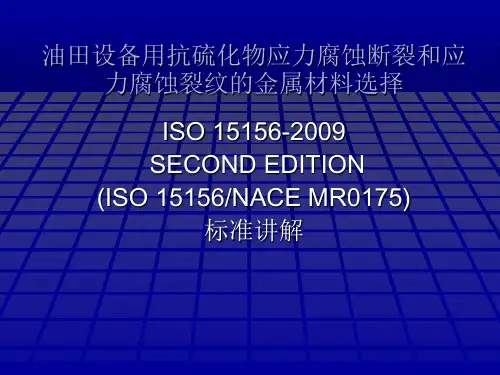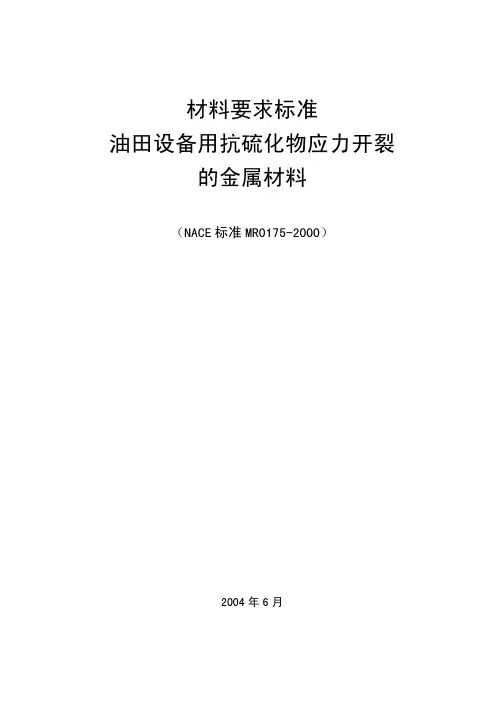酸性环境选材 NACE MR0175学习
- 格式:ppt
- 大小:2.45 MB
- 文档页数:48
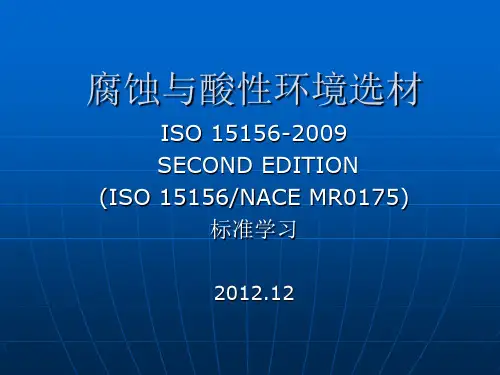


酸性环境的定义权威的酸性环境定义来自美国腐蚀工程师协会标准NACE MR0175“油田设备抗硫化物应力开裂金属材料要求标准”。
我国原石油部标准SYJ 12—85“天然气地面设施抗硫化物应力开裂金属材料要求”中,也沿用了NACE MR0175对酸性环境的定义。
一般来说,在含有水和硫化氢的天然气中,当气体中的硫化氢分压等于或大于0.000 35 MPa,称为天然气系统的酸性环境。
该酸性环境的定义是针对金属材料发生硫化物应力开裂(SSC)这种腐蚀形态来划分的。
在酸性环境的成分中,主要强调的是水、系统总压及H2S分压,而在这种溶液中,同时存在氢致开裂(HIC),电化学腐蚀(均匀腐蚀和局部腐蚀)等形态腐蚀的可能性。
应在压力容器设计中予以注意。
但在上述的酸性环境定义中,并未考虑到其他环境条件对SSC的作用,如pH值。
在欧洲联盟16号腐蚀公报“油气生产含H2S环境中碳钢和低合金钢材料要求指南”中,将pH值作为酸性环境划分的一个重要参数,见图1。
这已得到各国腐蚀界的重视和认同。
图1新的酸性环境划分图1.非酸性环境;2.过渡区;3.酸性环境酸性环境中的主要腐蚀类型及实例酸性环境中的腐蚀主要分为以下三类:1)硫化物应力开裂(SSC)。
金属材料在拉应力或残余应力和酸性环境腐蚀的联合作用下,易发生低应力且无任何预兆的突发性断裂,称作硫化物应力开裂(SSC),这是酸性环境(又称为湿硫化氢环境)中破坏性和危害性最大的一种腐蚀。
2)氢致开裂(HIC)。
酸性环境中的钢材常因腐蚀产生原子态氢, 由于H2S介质的存在,阻滞了氢原子结合生成H2分子,促进了原子氢向钢材中的扩散,在夹杂物或其他微观组织结构的不连续区域聚集成氢分子,并产生很高的压力,形成HIC(又称为阶梯形裂纹SWC)。
HIC常见于延性较好的低、中强度的管线用钢和容器用钢。
其特点:一是它可以在甚至没有拉伸应力附加的情况下发生(而SSC在一定的应力水平下才发生),也不是象SSC那样具有突发性;二是HIC表现为阶梯裂纹。
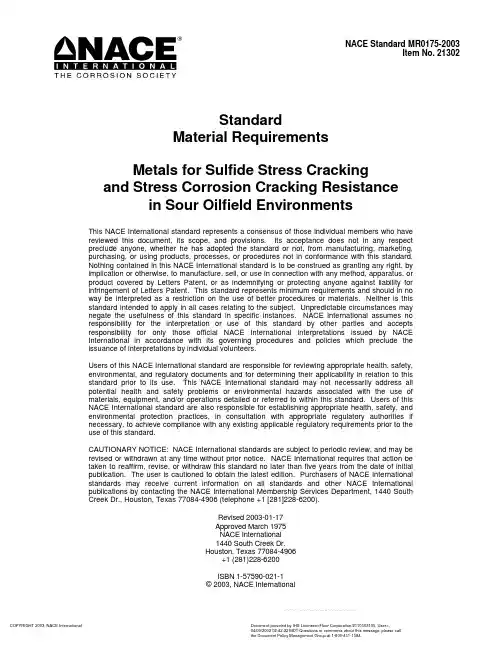
StandardMaterial RequirementsMetals for Sulfide Stress Crackingand Stress Corrosion Cracking Resistancein Sour Oilfield EnvironmentsThis NACE International standard represents a consensus of those individual members who have reviewed this document, its scope, and provisions. Its acceptance does not in any respect preclude anyone, whether he has adopted the standard or not, from manufacturing, marketing, purchasing, or using products, processes, or procedures not in conformance with this standard. Nothing contained in this NACE International standard is to be construed as granting any right, by implication or otherwise, to manufacture, sell, or use in connection with any method, apparatus, or product covered by Letters Patent, or as indemnifying or protecting anyone against liability for infringement of Letters Patent. This standard represents minimum requirements and should in no way be interpreted as a restriction on the use of better procedures or materials. Neither is this standard intended to apply in all cases relating to the subject. Unpredictable circumstances may negate the usefulness of this standard in specific instances. NACE International assumes no responsibility for the interpretation or use of this standard by other parties and accepts responsibility for only those official NACE International interpretations issued by NACE International in accordance with its governing procedures and policies which preclude the issuance of interpretations by individual volunteers.Users of this NACE International standard are responsible for reviewing appropriate health, safety, environmental, and regulatory documents and for determining their applicability in relation to this standard prior to its use. This NACE International standard may not necessarily address all potential health and safety problems or environmental hazards associated with the use of materials, equipment, and/or operations detailed or referred to within this standard. Users of this NACE International standard are also responsible for establishing appropriate health, safety, and environmental protection practices, in consultation with appropriate regulatory authorities if necessary, to achieve compliance with any existing applicable regulatory requirements prior to the use of this standard.CAUTIONARY NOTICE: NACE International standards are subject to periodic review, and may be revised or withdrawn at any time without prior notice. NACE International requires that action be taken to reaffirm, revise, or withdraw this standard no later than five years from the date of initial publication. The user is cautioned to obtain the latest edition. Purchasers of NACE International standards may receive current information on all standards and other NACE International publications by contacting the NACE International Membership Services Department, 1440 South Creek Dr., Houston, Texas 77084-4906 (telephone +1 [281]228-6200).Revised 2003-01-17 Approved March 1975 NACE International 1440 South Creek Dr. Houston, Texas 77084-4906+1 (281)228-6200ISBN 1-57590-021-1 © 2003, NACE InternationalNACE Standard MR0175-2003Item No. 21302MR0175-2003 ________________________________________________________________________ForewordThis NACE standard materials requirement is one step in a series of committee studies, reports,symposia, and standards that have been sponsored by former Group Committee T-1 (CorrosionControl in Petroleum Production) relating to the general problems of sulfide stress cracking (SSC)and stress corrosion cracking (SCC) of metals. Much of this work has been directed toward theoil- and gas-production industry. This standard is a materials requirement for metals used in oiland gas service exposed to sour gas, to be used by oil and gas companies, manufacturers,engineers, and purchasing agents. Many of the guidelines and specific requirements in thisstandard are based on field experience with the materials listed, as used in specific components,and may be applicable to other components and equipment in the oil-production industry or toother industries, as determined by the user. Users of this standard must be cautious inextrapolating the content of this standard for use beyond its scope.The materials, heat treatments, and metal-property requirements given in this standard representthe best judgment of Task Group 081 (formerly T-1F-1) and its administrative Specific TechnologyGroup (STG) 32 on Oil and Gas Production—Metallurgy (formerly Unit Committee T-1F onMetallurgy of Oilfield Equipment).This NACE standard updates and supersedes all previous editions of MR0175. The original 1975edition of the standard superseded NACE Publication 1F166 (1973 Revision) titled “SulfideCracking-Resistant Metallic Materials for Valves for Production and Pipeline Service,” and NACEPublication 1B163 titled “Recommendation of Materials for Sour Service” (which included TentativeSpecifications 150 on valves, 51 on severe weight loss, 60 on tubular goods, and 50 on nominalweight loss).This standard will be revised as necessary to reflect changes in technology. (See Sections 13, 14,and 15.)Whenever possible, the recommended materials are defined by reference to accepted genericdescriptors (such as UNS(1) numbers) and/or accepted standards, such as AISI,(2) API,(3) ASTM,(4)or DIN(5) standards.In NACE standards, the terms shall, must, should, and may are used in accordance with thedefinitions of these terms in the NACE Publications Style Manual, 4th ed., Paragraph 7.4.1.9. Shalland must are used to state mandatory requirements. Should is used to state something consideredgood and is recommended but is not mandatory. May is used to state something consideredoptional.This NACE International standard represents a consensus of those individual members who havereviewed this document, its scope, and provisions. Its acceptance does not in any respect precludeanyone, whether he has adopted the standard or not, from manufacturing, marketing, purchasing, orusing products, processes, or procedures not in conformance with this standard. Nothing containedin this NACE International standard is to be construed as granting any right, by implication orotherwise, to manufacture, sell, or use in connection with any method, apparatus, or product coveredby Letters Patent, or as indemnifying or protecting anyone against liability for infringement of LettersPatent. This standard represents minimum requirements and should in no way be interpreted as arestriction on the use of better procedures or materials.(1) Metals and Alloys in the Unified Numbering System (latest revision), a joint publication of ASTM International (ASTM) and the Society of Automotive Engineers Inc. (SAE), 400 Commonwealth Drive, Warrendale, PA 15096.(2) American Iron and Steel Institute (AISI), 1101 17th St. NW, Suite 1300, Washington, DC 20036.(3) American Petroleum Institute (API), 1220 L St. NW, Washington, DC 20005.(4) ASTM International (ASTM), 100 Barr Harbor Dr., West Conshohocken, PA 19428-2959.(5) Deutsches Institut für Normung (DIN), Burggrafenstrasse 6, D-10787 Berlin, Germany. --` , ` ` ` , ` ` ` , , ` , , ` ` , , , ` , , ` , , , , , ` -` -` , , ` , , ` , ` , , ` ---MR0175-2003________________________________________________________________________NACE InternationalStandardMaterial RequirementsMetals for Sulfide Stress Crackingand Stress Corrosion Cracking Resistancein Sour Oilfield EnvironmentsContents1. General (1)2. Definitions (5)3. Carbon and Low-Alloy Steels and Cast Irons (8)4. Corrosion-Resistant Alloys (CRAs)—All Other Alloys Not Defined as Carbon and Low-Alloy Steels and Cast Irons in Section 3 (9)5. Fabrication (14)6. Bolting (15)7. Platings and Coatings (16)8. Special Components (16)9. Wellheads, Christmas Trees, Valves, Chokes, and Level Controllers (17)10. Downhole Casing, Downhole Tubing, and Downhole Equipment (19)11. Wells, Flow Lines, Gathering Lines, Facilities, and Field Processing Plants (22)12. Drilling and Well-Servicing Equipment (24)13. Adding New Materials for MR0175 Section 3: Carbon and Low-Alloy Steels and CastIrons (25)14. Adding New Materials for MR0175 Section 4: Corrosion-Resistant Alloys (CRAs)—AllOther Alloys Not Defined as Carbon and Low-Alloy Steelsand Cast Irons in Section 3 (26)15. Proposing Changes and Making Additions for MR0175 Sections 5 Through 11:Fabrication, Welding, and Specific Equipment (27)16. Materials for Application-Specific Cases Without Proposing Adding New Materials toMR0175 (27)References (28)Appendix A—Sample Calculations of the Partial Pressure of H2S (30)Appendix B—Sample Test Data Tables (33)Appendix C—Ballot Submittal Data (34)Appendix D—Acceptable Materials (41)FIGURE 1: Road Map for MR0175 (4)FIGURE A-1: Sour Gas Systems (see Paragraph 1.4) (31)FIGURE A-2: Sour Multiphase Systems (see Paragraph 1.4) (32)________________________________________________________________________MR0175-2003 ________________________________________________________________________Section 1: General1.1 ScopeThis standard presents metallic material requirements to provide resistance to sulfide stress cracking (SSC) and/or stress corrosion cracking (SCC) for petroleum production, drilling, gathering and flow line equipment, and field processing facilities to be used in hydrogen sulfide (H2S)-bearing hydrocarbon service.This standard is applicable to the materials and/or equipment specified by the materials standards institutions listed in Table 1 (or by equivalent standards or specifications of other agencies).This standard does not include and is not intended to include design specifications. Other forms of corrosion and other modes of failure, although outside the scope of this standard, should also be considered in design and operation of equipment. Severely corrosive conditions may lead to failures by mechanisms other than SSC and/or SCC and should be mitigated by corrosion inhibition or materials selection, which are outside the scope of this standard. For example, some lower-strength steels used for pipelines and vessels may be subjected to failure by hydrogen-induced cracking (blistering and stepwise cracking) as a result of hydrogen damage associated with general corrosion in the presence of H2S.1,2TABLE 1Sources of Material Standards1. Aerospace Material Specifications (AMS): Society of Automotive Engineers Inc. (SAE), 400 Commonwealth Drive, Warrendale, PA 15096.2. American Iron and Steel Institute (AISI), 1101 17th St. NW, Suite 1300, Washington, DC 20036.3. American National Standards Institute (ANSI), 11 West 42nd St., New York, NY 10036.4. American Petroleum Institute (API), 1220 L St. NW, Washington, DC 20005.5. ASME International (ASME), Three Park Ave., New York, NY 10016-5990.6. ASTM International (ASTM), 100 Barr Harbor Dr., West Conshohocken, PA 19428-2959.7. American Welding Society (AWS), P.O. Box 251040, Miami, FL 33126.8. British Standards Institution (BSI), British Standards House, 389 Chiswick High Rd., London W4 4AL, United Kingdom.9. CSA International, 178 Rexdale Blvd., Etobicoke, Ontario, Canada M9W 1R3.10. Deutsches Institut für Normung (DIN), Burggrafenstrasse 6, D-10787, Berlin, Germany.1.2 ProcurementIt is the responsibility of the user to determine the operating conditions and to specify when this standard applies.(6) A variety of candidate materials may be selected from this standard for any given component. The manufacturer is responsible for meeting metallurgical requirements. It is the user’s responsibility to ensure that a material will be satisfactory in the intended environment. The user may select specific materials for use on the basis of operating conditions that include pressure, temperature, corrosiveness, fluid properties, etc. For example, when bolting components are selected, the pressure rating of flanges could be affected. The following could be specifiedat the user’s option: (1) materials from this standard usedby the manufacturer, and (2) materials from this standard proposed by the manufacturer and approved by the user. Itis always the responsibility of the equipment user to convey the environmental conditions to the equipment supplier, particularly if the equipment will be used in sour service. 1.3 ApplicabilityThis standard applies to all components of equipment exposed to sour environments, where failure by SSC or SCC would (1) prevent the equipment from being restored to an operating condition while continuing to contain pressure, (2) compromise the integrity of the pressure-containment system, and/or (3) prevent the basic function of the equipment from occurring. Materials selection for items such as atmospheric and low-pressure systems, water-handling facilities, sucker rods, and subsurface pumps are covered in greater detail in other NACE International and API documents and are outside the scope of this standard. 1.4 MR0175 ApplicationSulfide stress cracking (SSC) is affected by the following factors:(1) metallurgical condition and strength, which are affected by chemical composition, heat treatment, cold work, and microstructure;___________________________ (6) See Section 2 for the definition of user. --`,```,```,,`,,``,,,`,,`,,,,,`-`-`,,`,,`,`,,`---MR0175-2003(2) hydrogen ion concentration (activity) (pH) of the water phase;(3) H2S partial pressure, which is a function of the H2S concentration and total absolute pressure;(4) total tensile stress (applied plus residual);(5) temperature;(6) exposure duration;(7) galvanic effects;(8) chloride or other halide ion concentration;(9) oxidants; and(10) non-production fluids (including those used for acid stimulation and for packer fluids).Stress corrosion cracking (SCC) in sour service is affected by the following factors:(1) metallurgical condition and strength, which are affected by chemical composition, cold work, heat treatment, and microstructure;(2) hydrogen ion concentration (activity) (pH) of the water phase;(3) H2S partial pressure, which is a function of the H2S concentration and total absolute pressure;(4) total tensile stress (applied plus residual);(5) temperature;(6) exposure duration;(7) galvanic effects;(8) chloride or other halide ion concentration;(9) oxidants; and(10) non-production fluids (including those used for acid stimulation and for packer fluids).The user shall determine whether or not the environmental conditions are such that MR0175 applies. Please see Appendix A for sample calculations.1.4.1 MR0175 shall apply to conditions containingwater as a liquid and H2S exceeding the limits defined in Paragraph 1.4.1.1. Highly susceptible materials may fail in less severe environments.1.4.1.1 All gas, gas condensate, and sour crudeoil (except as noted in Paragraph 1.4.2)When the partial pressure of H2S in a wet (wateras a liquid) gas phase of a gas, gas condensate,or crude oil system is equal to or exceeds 0.0003MPa abs (0.05 psia).1.4.2 MR0175 need not apply (the user shalldetermine) when the following conditions exist:1.4.2.1 Low-pressure gasWhen the total pressure is less than 0.45 MPa abs(65 psia).1.4.2.2 Low-pressure oil and gas multiphasesystemsWhen the total pressure is less than 1.83 MPa abs(265 psia), the maximum gas:oil ratio is 142SCM:bbl (5,000 SCF:bbl), the H2S content is lessthan 15 mol%, and the H2S partial pressure is lessthan 0.07 MPa abs (10 psia).1.4.2.3 Salt water wells and salt water handlingfacilities. These are covered by NACE StandardRP0475.31.4.2.4 Refineries and chemical plants.1.4.2.5 Parts loaded in compression.1.5 Control of SSC and/or SCC1.5.1 SSC and/or SCC may be controlled by any or allof the following measures:(1) using the materials and processes described inthis standard;(2) controlling the environment;(3) isolating the components from the sourenvironment; or(4) using appropriate anodic or cathodicpolarization.Metals susceptible to SSC and/or SCC have beenused successfully by controlling drilling or workoverfluid properties, during drilling and workover operations,respectively.1.6 Materials Included in MR01751.6.1 Metallic materials have been included in thisstandard as acceptable materials based on theirresistance to SSC and/or SCC either in actual fieldapplications, in SSC and SCC laboratory tests, or both.Many alloys included in the first edition of MR0175 hadproved to be satisfactory in sour service even thoughthey might have cracked in standard SSC and/or SCClaboratory tests, such as those addressed in NACEStandard TM0177.4--`,```,```,,`,,``,,,`,,`,,,,,`-`-`,,`,,`,`,,`---MR0175-20031.6.2 Materials included in this standard are resistantto, but not necessarily immune to, SSC and/or SCC instated conditions. Improper design, manufacturing, installation, selection, or handling can cause resistantmaterials to become susceptible to SSC and/or SCC.1.7 Hardness Requirements1.7.1 Because hardness testing is nondestructive, it isused by manufacturers as a quality control method andby users as a field inspection method. Accurate hardness testing requires strict compliance with the methods described in appropriate ASTM standards.1.7.2 Hardness tests sufficient to establish the actualhardness of the material or component being examinedshall be made. Individual hardness readings exceeding the value permitted by this standard are considered acceptable if the average of several readings taken within close proximity does not exceedthe value permitted by this standard and no individualreading is greater than 2 Rockwell C hardness (HRC)units above the acceptable value. The number and location of test areas are outside the scope of this standard.1.7.3 The HRC scale is referred to throughout thisstandard. Rockwell C hardness values measured in accordance with ASTM E 185 shall be the primary basis for acceptance. Brinell hardness (HBW), Vickers(HV) 5-kg or 10-kg, or other hardness testing methodsmay be used. When applicable, conversion of hard-ness values obtained by these other test methods to HRC values shall be made in accordance with ASTM E140.6 (7) Empirical conversion data are acceptable whenapproved by the purchaser. Acceptance criteria usingmicrohardness testing, as defined by ASTM E 384,7are considered outside the scope of this standard.1.8 How to Use MR0175 (a Road Map)1.8.1 See Figure 1. A user of materials in sour servicemust first determine whether MR0175 is applicable forthe intended application. Section 1 of MR0175 may beused for guidance. Refer to Section 2 for definitions ofterms used in MR0175.1.8.2 If the user chooses to use MR0175 for materialsselection in sour service, the process involves determining whether the desired materials are within the scope of the standard, the metallurgical requirements for the materials, and the environmentalrestrictions, if any, for the material. 1.8.3 The following process should be used for finding acceptable materials and their requirements in MR0175:1.8.3.1 For carbon steels, low-alloy steels, andcast irons, first review Section 3. This sectioncontains the most general requirements forwidespread applications of these alloys.1.8.3.1.1 If questions about these alloys arenot adequately answered in Section 3 or if thealloy in question is not within the scope ofSection 3, review requirements for specifictypes of equipment in Sections 6, 8, 9, 10, 11,and 12.1.8.3.1.2 For specific requirements duringfabrication, including welding, review Section5.1.8.3.1.3For plating and coatings applications of these alloys, see Section 7.1.8.3.2 The process is the same for selectingcorrosion-resistant alloys (CRAs) except that thegeneral requirements are first found in Section 4.Section 4 contains specific alloys and groups ofalloys (categories); these are discussed inParagraph 1.8.3.3.1.8.3.2.1 See Appendix C for previouslysubmitted ballot data. This appendix givesinformation on data submitted for ballot foracceptance into MR0175.1.8.3.3 Individual Alloys Versus Alloy CategoriesSection 4 lists CRAs as individual alloys or in alloycategories. Alloy (CRA) categories permit abroad-based description of similar alloys. A CRAcategory in Section 4 defines a group of alloys interms of broad-based but essential chemicalcompositions, manufacturing processes, andfinished conditions. The entire chemicalcomposition range of an alloy shall meet all therequirements of the given CRA category in orderto be included within the category.1.8.3.3.1 All applicable environmentalrestrictions are defined for all of the alloys inthe category. These environmental restrict-tions may include the maximum acceptablepartial pressures of H2S, minimum acceptablewater pH, maximum acceptable chlorides inthe water, temperature, and whether thepresence of elemental sulfur is acceptable.__________________________________________(7) The hardness correlation tabulated in ASTM E 140 does not apply to martensitic stainless steels and precipitation-hardened stainless steels. When hardness is measured by Brinell testing, the permissible limit for UNS J91540 (CA6NM) and UNS S42000 is 255 HBW maximum, which has been empirically determined to be equivalent to 23 HRC for these alloys. For materials not listed in ASTM E 140, empirical data are acceptable in determining hardness conversion. --` , ` ` ` , ` ` ` , , ` , , ` ` , , , ` , , ` , , , , , ` -` -` , , ` , , ` , ` , , ` ---MR0175-2003When environmental restrictions are listed in tables, interpolation between H2S partial pressures, temperatures, etc., is permitted.1.8.3.3.2 Some categories may include alloy-specific requirements. These are metallurgical requirements typically restricting chemistry and hardness.1.8.3.3.3 Examples of CRA individual alloy and CRA category use:Individual CRA Alloy Example: UNS J93254 (CK3MCuN) is listed in Paragraph 4.3.2 as an individual alloy. All requirements for this alloy are located solely in Paragraph 4.3.2.CRA Category Example: The ferritic stainless steels in Paragraph 4.7.1 are listed as an alloy category. Any ferritic stainless steel may be used within the environmental restrictionsof this paragraph. Individual alloys do not have to be listed.CRA Category with Specific Alloy Require-ments Example: The martensitic stainless steels are more loosely grouped in Paragraph 4.8 as a category with alloy-specific requirements. Environmental restricttions are the same for all of the martensitic stainless steels, but there are metallurgicalrequirements for each of the alloys within thecategory.1.8.4 If the material in question is outside the scope of MR0175, the following options may be used:1.8.4.1 See Sections 13, 14, and 15 for proposalsfor balloting changes and additions to all sections of MR0175. See Appendix B for sample test data tables and the definition of available Test Levels I through VII.1.8.4.2 See Section 16 for guidance through aprocess for choosing materials for application-specific cases without proposing to add new materials to MR0175.1.8.5 Four appendixes are included in this standard.1.8.5.1 Appendix A provides sample calculationsof the partial pressure of H2S.1.8.5.2 Appendix B provides sample test datatables.1.8.5.3 Appendix C provides ballot submittal datain tabular form.1.8.5.4 Appendix D provides lists of acceptablematerials for various applications.FIGURE 1 Road Map for MR0175 --` , ` ` ` , ` ` ` , , ` , , ` ` , , , ` , , ` , , , , , ` -` -` , , ` , , ` , ` , , ` ---MR0175-20031.9 Materials are added to MR0175 either as an individual alloy or as alloy categories. Ballot items shall conform to the standard’s method. If a ballot proposes an addition of an individual alloy or modification to the requirements for that alloy, the ballot must address only that individual alloy. Conversely, if a ballot proposes an addition or modification of requirements for alloys in a category, the ballot must address the category of alloys.1.10 The Effect of Changing Requirements in MR0175 on Existing EquipmentWhen new restrictions are placed on materials in this standard or when materials are deleted from this standard, materials in use at the time of the change that complied with this standard prior to the standard revision and that have not experienced SSC and SCC failures in their local environment are in compliance with this standard. However, when these materials are removed from their local environment, the replacement materials must be listed in this standard at the time of replacement in order to be in compliance with this standard.1.10.1 Successful use of materials outside thelimitations of MR0175 may be perpetuated by qualification in accordance with Section 16.1.10.2 The user may replace materials in kind forexisting wells or for new wells within a given field if the design basis for the equipment has not changed. The user shall verify that the environmental conditions of the field have not changed to dictate the need for new materials substitutions, and the replacement materials are the same.________________________________________________________________________Section 2: DefinitionsAge Hardening: Hardening (strengthening) by aging, usually after rapid cooling or cold working.Aging: A change in metallurgical properties that generally occurs slowly at room temperature (natural aging) and more rapidly at higher temperature (artificial aging).Annealing: Heating a metal to a suitable temperature, holding at that temperature for a suitable period of time, and then cooling at a suitable rate, for such purposes as reducing hardness, improving machinability, or obtaining desired properties.Austenite: The face-centered cubic crystalline phase of ferrous or nonferrous alloys.Austenitic Steel: A steel whose microstructure at room temperature consists predominantly of austenite.Austenitizing: Forming austenite by heating a ferrous metal to a temperature in the transformation range (partial austenitizing) or above the transformation range (complete austenitizing).Blowout Preventers: Mechanical devices capable of containing pressure, used for control of well fluids and drilling fluids during drilling operations.Brazing: Joining metals by flowing a thin layer (of capillary thickness) of a lower-melting-point nonferrous filler metal in the space between them.Brinell Hardness: A hardness value obtained by use of a 10-mm diameter hardened steel (or carbide) ball and normally a load of 3,000 kg, in accordance with ASTM E 10.8Burnishing: Smoothing surfaces with frictional contact between the material and some other hard pieces of material, such as hardened steel balls.Carbon Steel: An alloy of carbon and iron containing up to2% carbon and up to 1.65% manganese and residual quantities of other elements, except those intentionally added in specific quantities for deoxidation (usually siliconand/or aluminum). Carbon steels used in the petroleum industry usually contain less than 0.8% carbon.Case Hardening: Hardening a ferrous alloy so that the outer portion, or case, is made substantially harder than the inner portion, or core. Typical processes are carburizing, cyaniding, carbonitriding, nitriding, induction hardening, and flame hardening.Cast Component (Casting): A piece of metal that is formed at or near its finished shape by the solidification of molten metal in a mold.Cast Iron: An iron-carbon alloy containing approximately 2to 4% carbon. Cast irons may be classified as:(1) gray cast iron—cast iron that gives a gray fracture as a result of the presence of flake graphite;(2) white cast iron—cast iron that gives a white fracture asa result of the presence of cementite (Fe3C);(3) malleable cast iron—white cast iron that is thermally treated to convert most or all of the cementite to graphite (temper carbon);(4) ductile (nodular) cast iron—cast iron that has been treated while molten with an element (usually magnesium or cerium) that spheroidizes the graphite; or--`,```,```,,`,,``,,,`,,`,,,,,`-`-`,,`,,`,`,,`---。
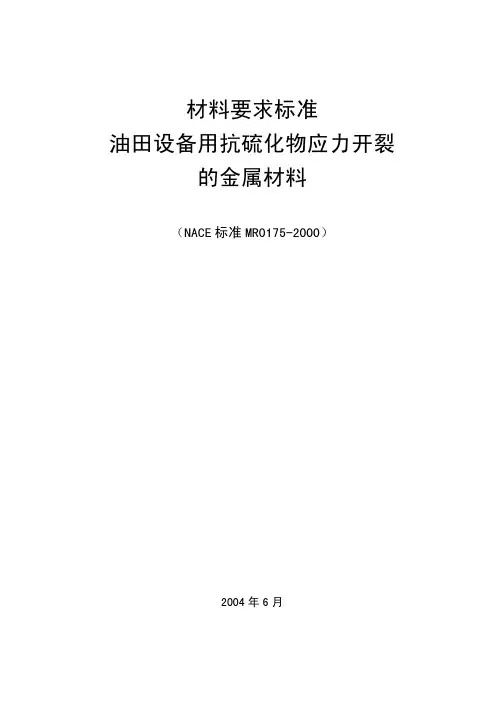

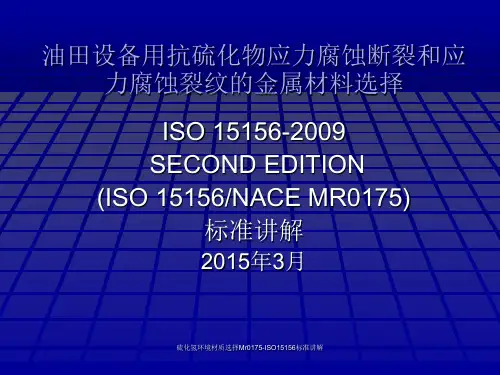
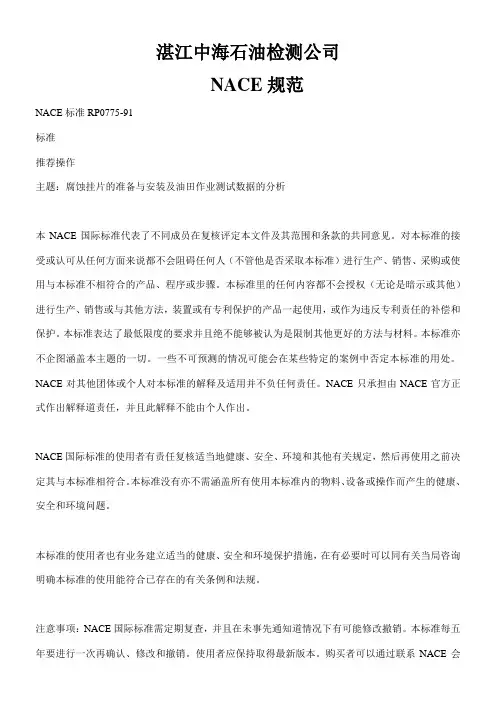
湛江中海石油检测公司NACE规范NACE标准RP0775-91标准推荐操作主题:腐蚀挂片的准备与安装及油田作业测试数据的分析本NACE国际标准代表了不同成员在复核评定本文件及其范围和条款的共同意见。
对本标准的接受或认可从任何方面来说都不会阻碍任何人(不管他是否采取本标准)进行生产、销售、采购或使用与本标准不相符合的产品、程序或步骤。
本标准里的任何内容都不会授权(无论是暗示或其他)进行生产、销售或与其他方法,装置或有专利保护的产品一起使用,或作为违反专利责任的补偿和保护。
本标准表达了最低限度的要求并且绝不能够被认为是限制其他更好的方法与材料。
本标准亦不企图涵盖本主题的一切。
一些不可预测的情况可能会在某些特定的案例中否定本标准的用处。
NACE对其他团体或个人对本标准的解释及适用并不负任何责任。
NACE只承担由NACE官方正式作出解释道责任,并且此解释不能由个人作出。
NACE国际标准的使用者有责任复核适当地健康、安全、环境和其他有关规定,然后再使用之前决定其与本标准相符合。
本标准没有亦不需涵盖所有使用本标准内的物料、设备或操作而产生的健康、安全和环境问题。
本标准的使用者也有业务建立适当的健康、安全和环境保护措施,在有必要时可以同有关当局咨询明确本标准的使用能符合已存在的有关条例和法规。
注意事项:NACE国际标准需定期复查,并且在未事先通知道情况下有可能修改撤销。
本标准每五年要进行一次再确认、修改和撤销。
使用者应保持取得最新版本。
购买者可以通过联系NACE会员服务部(地址:德克萨斯,休斯顿,218340邮箱,电话:1-281-6200)获得所有本标准的最新信息。
1975年通过(批准)1987年(修订)1991年(修订)腐蚀工程国家协会(NACE)腐蚀工程国家协会,1991版前言本标准建议并鼓励使用统一并且得到认证的方法来监测油田作业的失重腐蚀现象。
本标准对准备、分析和安装金属腐蚀挂片的步骤进行了概述。
解释腐蚀挂片的因素也包括在内。
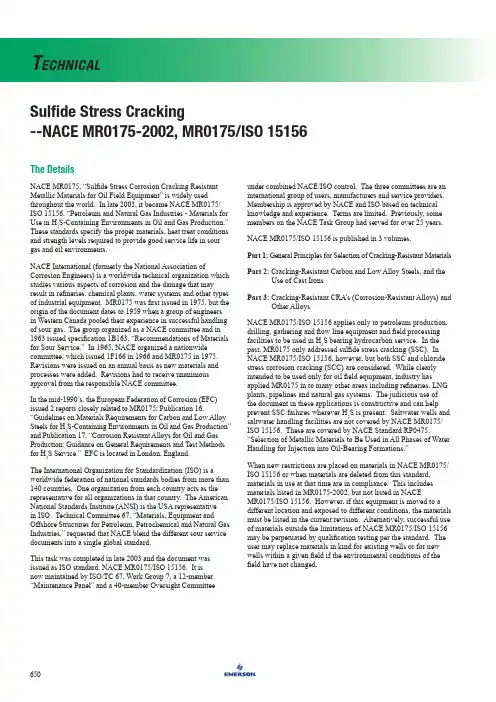
Sulfide Stress Cracking--NACE MR0175-2002, MR0175/ISO 15156650The DetailsNACE MR0175, “Sulfide Stress Corrosion Cracking Resistant Metallic Materials for Oil Field Equipment” is widely used throughout the world. In late 2003, it became NACE MR0175/ISO 15156, “Petroleum and Natural Gas Industries - Materials for Use in H 2S-Containing Environments in Oil and Gas Production.” These standards specify the proper materials, heat treat conditions and strength levels required to provide good service life in sour gas and oil environments.NACE International (formerly the National Association ofCorrosion Engineers) is a worldwide technical organization which studies various aspects of corrosion and the damage that may result in refineries, chemical plants, water systems and other types of industrial equipment. MR0175 was first issued in 1975, but the origin of the document dates to 1959 when a group of engineers in Western Canada pooled their experience in successful handling of sour gas. The group organized as a NACE committee and in 1963 issued specification 1B163, “Recommendations of Materials for Sour Service.” In 1965, NACE organized a nationwide committee, which issued 1F166 in 1966 and MR0175 in 1975. Revisions were issued on an annual basis as new materials and processes were added. Revisions had to receive unanimous approval from the responsible NACE committee.In the mid-1990’s, the European Federation of Corrosion (EFC) issued 2 reports closely related to MR0175; Publication 16,“Guidelines on Materials Requirements for Carbon and Low Alloy Steels for H 2S-Containing Environments in Oil and Gas Production” and Publication 17, “Corrosion Resistant Alloys for Oil and Gas Production: Guidance on General Requirements and Test Methods for H 2S Service.” EFC is located in London, England.The International Organization for Standardization (ISO) is aworldwide federation of national standards bodies from more than 140 countries. One organization from each country acts as the representative for all organizations in that country. The American National Standards Institute (ANSI) is the USA representative in ISO. Technical Committee 67, “Materials, Equipment andOffshore Structures for Petroleum, Petrochemical and Natural Gas Industries,” requested that NACE blend the different sour service documents into a single global standard.This task was completed in late 2003 and the document was issued as ISO standard, NACE MR0175/ISO 15156. It is now maintained by ISO/TC 67, Work Group 7, a 12-member “Maintenance Panel” and a 40-member Oversight Committeeunder combined NACE/ISO control. The three committees are an international group of users, manufacturers and service providers. Membership is approved by NACE and ISO based on technical knowledge and experience. Terms are limited. Previously, some members on the NACE Task Group had served for over 25 years.NACE MR0175/ISO 15156 is published in 3 volumes.Part 1: General Principles for Selection of Cracking-Resistant Materials Part 2: Cracking-Resistant Carbon and Low Alloy Steels, and the Use of Cast IronsPart 3: Cracking-Resistant CRA’s (Corrosion-Resistant Alloys) and Other AlloysNACE MR0175/ISO 15156 applies only to petroleum production, drilling, gathering and flow line equipment and field processing facilities to be used in H 2S bearing hydrocarbon service. In the past, MR0175 only addressed sulfide stress cracking (SSC). In NACE MR0175/ISO 15156, however, but both SSC and chloride stress corrosion cracking (SCC) are considered. While clearly intended to be used only for oil field equipment, industry hasapplied MR0175 in to many other areas including refineries, LNG plants, pipelines and natural gas systems. The judicious use of the document in these applications is constructive and can help prevent SSC failures wherever H 2S is present. Saltwater wells and saltwater handling facilities are not covered by NACE MR0175/ISO 15156. These are covered by NACE Standard RP0475,“Selection of Metallic Materials to Be Used in All Phases of Water Handling for Injection into Oil-Bearing Formations.”When new restrictions are placed on materials in NACE MR0175/ISO 15156 or when materials are deleted from this standard, materials in use at that time are in compliance. This includes materials listed in MR0175-2002, but not listed in NACEMR0175/ISO 15156. However, if this equipment is moved to a different location and exposed to different conditions, the materials must be listed in the current revision. Alternatively, successful use of materials outside the limitations of NACE MR0175/ISO 15156 may be perpetuated by qualification testing per the standard. The user may replace materials in kind for existing wells or for new wells within a given field if the environmental conditions of the field have not changed.Sulfide Stress Cracking--NACE MR0175-2002, MR0175/ISO 15156651New Sulfide Stress Cracking Standard for RefineriesDon Bush, Principal Engineer - Materials, at Emerson Process Management Fisher Valves, is a member and former chair of a NACE task group that has written a document for refinery applications, NACE MR0103. The title is “Materials Resistant to Sulfide Stress Cracking in Corrosive Petroleum RefiningEnvironments.” The requirements of this standard are very similar to the pre-2003 MR0175 for many materials. When applying this standard, there are changes to certain key materials compared with NACE MR0175-2002.ResponsibilityIt has always been the responsibility of the end user to determine the operating conditions and to specify when NACE MR0175applies. This is now emphasized more strongly than ever in NACE MR0175/ISO 15156. The manufacturer is responsible for meeting the metallurgical requirements of NACE MR0175/ISO 15156. It is the end user’s responsibility to ensure that a material will be satisfactory in the intended environment. Some of the operating conditions which must be considered include pressure, temperature, corrosiveness, fluid properties, etc. When bolting components are selected, the pressure rating of flanges could be affected. It is always the responsibility of the equipment user to convey the environmental conditions to the equipment supplier, particularly if the equipment will be used in sour service.The various sections of NACE MR0175/ISO 15156 cover the commonly available forms of materials and alloy systems. The requirements for heat treatment, hardness levels, conditions of mechanical work and post-weld heat treatment are addressed for each form of material. Fabrication techniques, bolting, platings and coatings are also addressed.Applicability of NACE MR0175/ISO 15156Low concentrations of H 2S (<0.05 psi (0,3 kPa) H 2S partialpressure) and low pressures (<65 psia or 450 kPa) are considered outside the scope of NACE MR0175/ISO 15156. The low stress levels at low pressures or the inhibitive effects of oil may give satisfactory performance with standard commercial equipment. Many users, however, have elected to take a conservative approach and specify compliance to either NACE MR0175 or NACE MR0175/ISO 15156 any time a measurable amount of H 2S is present. The decision to follow these specifications must be made by the user based on economic impact, the safety aspects should a failure occur and past field experience. Legislation can impact the decision as well. Such jurisdictions include; the Texas Railroad Commission and the U.S. Minerals Management Service (offshore). The Alberta, Canada Energy Conservation Board recommends use of the specifications.Basics of Sulfide Stress Cracking (SSC) and Stress Corrosion Cracking (SCC)SSC and SCC are cracking processes that develop in the presence of water, corrosion and surface tensile stress. It is a progressive type of failure that produces cracking at stress levels that are well below the material’s tensile strength. The break or fracture appears brittle, with no localized yielding, plastic deformation or elongation. Rather than a single crack, a network of fine, feathery, branched cracks will form (see Figure 1). Pitting is frequently seen, and will serve as a stress concentrator to initiate cracking.With SSC, hydrogen ions are a product of the corrosion process (Figure 2). These ions pick up electrons from the base material producing hydrogen atoms. At that point, two hydrogen atoms may combine to form a hydrogen molecule. Most molecules will eventually collect, form hydrogen bubbles and float awayharmlessly. However, some percentage of the hydrogen atoms will diffuse into the base metal and embrittle the crystalline structure. When a certain critical concentration of hydrogen is reached and combined with a tensile stress exceeding a threshold level, SSC will occur. H 2S does not actively participate in the SSC reaction; however, sulfides act to promote the entry of the hydrogen atoms into the base material.As little as 0.05 psi (0,3 kPa) H 2S partial pressure in 65 psia (450 kPa) hydrocarbon gas can cause SSC of carbon and low alloy steels. Sulfide stress cracking is most severe at ambient temperature, particularly in the range of 20° to 120°F (-6° to49°C). Below 20°F (-6°C) the diffusion rate of the hydrogen isFigure 1. Photomicrograph Showing Stress Corrosion CrackingSulfide Stress Cracking--NACE MR0175-2002, MR0175/ISO 15156652so slow that the critical concentration is never reached. Above 120°F (49°C), the diffusion rate is so fast that the hydrogen atoms pass through the material in such a rapid manner that the critical concentration is not reached.Chloride SCC is widely encountered and has been extensively studied. Much is still unknown, however, about its mechanism. One theory says that hydrogen, generated by the corrosion process, diffuses into the base metal in the atomic form and embrittles the lattice structure. A second, more widely accepted theory proposes an electrochemical mechanism. Stainless steels are covered with a protective, chromium oxide film. The chloride ions rupture the film at weak spots, resulting in anodic (bare) and cathodic (film covered) sites. The galvanic cell produces accelerated attack at the anodic sites, which when combined with tensile stresses produces cracking. A minimum ion concentration is required to produce SCC. As the concentration increases, the environment becomes more severe, reducing the time to failure. Temperature also is a factor in SCC. In general, the likelihood of SCC increases with increasing temperature. A minimum threshold temperature exists for most systems, below which SCC is rare. Across industry, the generally accepted minimum temperature for chloride SCC of the 300 SST’s is about 160°F (71°C). NACE MR0175/ISO 15156 has set a very conservative limit of 140°F (60°C) due to the synergistic effects of the chlorides, H 2S and low pH values. As the temperature increases above these values, the time to failure will typically decrease.Resistance to chloride SCC increases with higher alloy materials. This is reflected in the environmental limits set by NACEMR0175/ISO 15156. Environmental limits progressively increase from 400 Series SST and ferritic SST to 300 Series, highly alloy austenitic SST, duplex SST, nickel and cobalt base alloys.Carbon SteelCarbon and low-alloy steels have acceptable resistance to SSC and SCC however; their application is often limited by their low resistance to general corrosion. The processing of carbon and low alloy steels must be carefully controlled for good resistance to SSC and SCC. The hardness must be less than 22 HRC. If welding or significant cold working is done, stress relief is required. Although the base metal hardness of a carbon or alloy steel is less than 22 HRC, areas of the heat affected zone (HAZ) will be harder. PWHT will eliminate these excessively hard areas.ASME SA216 Grades WCB and WCC and SAME SA105 are the most commonly used body materials. It is Fisher’s policy to stress relieve all welded carbon steels that are supplied to NACE MR0175/ISO 15156.All carbon steel castings sold to NACE MR0175/ISO 15156 requirements are produced using one of the following processes:1. In particular product lines where a large percentage of carbon steel assemblies are sold as NACE MR0175/ISO 15156 compliant, castings are ordered from the foundry with a requirement that the castings be either normalized or stress relieved following all weld repairs, major or minor. Any weld repairs performed, either major or minor, are subsequently stress relieved.2. In product lines where only a small percentage of carbon steel products are ordered NACE MR0175/ISO 15156 compliant, stock castings are stress relieved whether they are weld repaired by Emerson Process Management or not. This eliminates the chance of a minor foundry weld repair going undetected and not being stress relieved.ASME SA352 grades LCB and LCC have the same composition as WCB and WCC, respectively. They are heat treated differently and impact tested at -50°F (-46°C) to ensure good toughness in low temperature service. LCB and LCC are used in locations where temperatures commonly drop below the -20°F (-29°C) permitted for WCB and WCC. LCB and LCC castings are processed in the same manner as WCB and WCC when required to meet NACE MR0175/ISO 15156.For carbon and low-alloy steels NACE MR0175/ISO 15156imposes some changes in the requirements for the weld procedure qualification report (PQR). All new PQR’s will meet these requirements; however, it will take several years for Emerson Process Management and our suppliers to complete this work. At this time, we will require user approval to use HRC.S -2H++S -2S -2Figure 2. Schematic Showing the Generation of Hydrogen Producing SSCSulfide Stress Cracking--NACE MR0175-2002, MR0175/ISO 15156653Carbon and Low-Alloy Steel Welding hardness Requirements• HV-10, HV-5 or Rockwell 15N.• HRC testing is acceptable if the design stresses are less than 67% of the minimum specified yield strength and the PQR includes PWHT.• Other methods require user approval. • 250 HV or 70.6 HR15N maximum. • 22 HRC maximum if approved by user.Low-Alloy Steel Welding hardness Requirements• All of the above apply with the additional requirement of stress relieve at 1150°F (621°C) minimum after welding.All new PQR’s at Emerson Process Management and our foundries will require hardness testing with HV-10, HV-5 or Rockwell 15N and HRC. The acceptable maximum hardness values will be 250 HV or 70.6 HR15N and 22 HRC. Hardness traverse locations are specified in NACE MR0175/ISO 15156 part 2 as a function of thickness and weld configuration. The number and locations of production hardness tests are still outside the scope of the standard. The maximum allowable nickel content for carbon and low-alloy steels and their weld deposits is 1%.Low alloy steels like WC6, WC9, and C5 are acceptable to NACE MR0175/ISO 15156 to a maximum hardness of 22 HRC. These castings must all be stress relieved to FMS 20B52.The compositions of C12, C12a, F9 and F91 materials do not fall within the definition of “low alloy steel” in NACE MR0175/ISO 15156, therefore, these materials are not acceptable.A few customers have specified a maximum carbon equivalent (CE) for carbon steel. The primary driver for this requirement is to improve the SSC resistance in the as-welded condition. Fisher’s practice of stress relieving all carbon steel negates this need. Decreasing the CE reduces the hardenability of the steel and presumably improves resistance to sulfide stress cracking (SSC). Because reducing the CE decreases the strength of the steel, there is a limit to how far the CE can be reduced.Cast IronGray, austenitic and white cast irons cannot be used for anypressure-retaining parts, due to low ductility. Ferritic ductile iron to ASTM A395 is acceptable when permitted by ANSI, API or other industry standards.Stainless Steel400 Series Stainless SteelUNS 410 (410 SST), CA15 (cast 410), 420 (420 SST) and several other martensitic grades must be double tempered to a maximum hardness of 22 HRC. PWHT is also required. An environmental limit now applies to the martensitic grades; 1.5 psi (10 kPa) H 2S partial pressure and pH greater than or equal to 3.5, 416 (416 SST) is similar to 410 (410) with the exception of a sulfur addition to produce free machining characteristics. Use of 416 and other free machining steels is not permitted by NACE MR0175/ISO 15156.CA6NM is a modified version of the cast 410 stainless steel. NACE MR0175/ISO 15156 allows its use, but specifies the exact heat treatment required. Generally, the carbon content must be restricted to 0.03% maximum to meet the 23 HRCmaximum hardness. PWHT is required for CA6NM. The same environmental limit applies; 1.5 psi (10 kPa) H 2S partial pressure and pH greater than or equal to 3.5.300 Series Stainless SteelSeveral changes have been made with the requirements of the austenitic (300 Series) stainless steels. Individual alloys are no longer listed. All alloys with the following elemental ranges are acceptable: C 0.08% maximum, Cr 16% minimum, Ni 8% minimum, P 0.045% maximum, S 0.04% maximum, Mn 2.0% maximum, and Si 2.0% maximum. Other alloying elements are permitted. The other requirements remain; solution heat treated condition, 22 HRC maximum and free of cold work designed to improve mechanical properties. The cast and wrought equivalents of 302, 304 (CF8), S30403 (CF3), 310 (CK20), 316 (CF8M), S31603 (CF3M), 317 (CG8M), S31703 (CG3M), 321, 347 (CF8C) and N08020 (CN7M) are all acceptable per NACE MR0175/ISO 15156.Environmental restrictions now apply to the 300 Series SST. The limits are 15 psia (100 kPa) H 2S partial pressure, a maximum temperature of 140°F (60°C), and no elemental sulfur. If the chloride content is less than 50 mg/L (50 ppm), the H 2S partial pressure must be less than 50 psia (350 kPa) but there is no temperature limit.There is less of a restriction on 300 Series SST in oil and gas processing and injection facilities. If the chloride content in aqueous solutions is low (typically less than 50 mg/L or 50 ppm chloride) in operations after separation, there are no limits for austenitic stainless steels, highly alloyed austenitic stainless steels, duplex stainless steels, or nickel-based alloys.Sulfide Stress Cracking--NACE MR0175-2002, MR0175/ISO 15156654Post-weld heat treatment of the 300 Series SST is not required. Although the corrosion resistance may be affected by poorlycontrolled welding, this can be minimized by using the low carbon filler material grades, low heat input levels and low interpass temperatures. We impose all these controls as standard practice. NACE MR0175/ISO 15156 now requires the use of “L” grade consumables with 0.03% carbon maximum.S20910S20910 (Nitronic ® 50) is acceptable in both the annealed and high strength conditions with environmental restrictions; H 2S partial pressure limit of 15 psia (100 kPa), a maximum temperature of 150°F (66°C), and no elemental sulfur. This would apply to components such as bolting, plugs, cages, seat rings and other internal parts. Strain hardened (cold-worked) S20910 is acceptable for shafts, stems, and pins without any environmental restrictions. Because of the environmental restrictions and poor availability on the high strength condition, use of S20910 will eventually be discontinued except for shafts, stems and pins where unrestricted application is acceptable for these components.CK3MCuNThe cast equivalent of S31254 (Avesta 254SMO ®), CK3MCuN (UNS J93254), is included in this category. The same elemental limits apply. It is acceptable in the cast, solution heat-treatedcondition at a hardness level of 100 HRB maximum in the absence of elemental sulfur.S17400The use of S17400 (17-4PH) is now prohibited for pressure-retaining components including bolting, shafts and stems. Prior to 2003, S17400 was listed as an acceptable material in the general section (Section 3) of NACE MR0175. Starting with the 2003 revision, however, it is no longer listed in the general section. Its use is restricted to internal, non-pressure containing components in valves, pressure regulators and level controllers. This includes cages and other trim parts. 17-4 bolting will no longer be supplied in any NACE MR0175/ISO 15156 construction. The 17-4 and 15-5 must be heat-treated to the H1150 DBL condition or the H1150M condition. The maximum hardness of 33 HRC is the same for both conditions.CB7Cu-1 and CB7Cu-2 (cast 17-4PH and 15-5 respectively) in the H1150 DBL condition are also acceptable for internal valve and regulator components. The maximum hardness is 30 HRC or 310 HB for both alloys.Duplex Stainless SteelWrought and cast duplex SST alloys with 35-65% ferrite are acceptable based on the composition of the alloy, but there areenvironmental restrictions. There is no differentiation between cast and wrought, therefore, cast CD3MN is now acceptable. There are two categories of duplex SST. The “standard” alloys with a 30≤PREN≤40 and ≥1.5% Mo, and the “super” duplex alloys with PREN>40. The PREN is calculated from the composition of the material. The chromium, molybdenum, tungsten and nitrogen contents are used in the calculation. NACE MR0175/ISO 15156 uses this number for several classes of materials.PREN = Cr% + 3.3(Mo% + 0.5W%) + 16N%The “standard” duplex SST grades have environmental limits of450°F (232°C) maximum and H 2S partial pressure of 1.5 psia (10 kPa) maximum. The acceptable alloys include S31803, CD3MN, S32550 and CD7MCuN (Ferralium ® 255). The alloys must be in the solution heat-treated and quenched condition. There are no hardness restrictions in NACE MR0175/ISO 15156, however, 28 HRC remains as the limit in the refinery document MR0103.The “super” duplex SST with PREN>40 have environmental limits of 450°F (232°C) maximum and H 2S partial pressure of 3 psia (20 kPa) maximum. The acceptable “super” duplex SST’s include S32760 and CD3MWCuN (Zeron ® 100).The cast duplex SST Z 6CNDU20.08M to the French National Standard NF A 320-55 is no longer acceptable for NACE MR0175/ISO 15156 applications. The composition fails to meet the requirements set for either the duplex SST or the austenitic SST.highly Alloyed Austenitic Stainless SteelsThere are two categories of highly alloyed austenitic SST’s that are acceptable in the solution heat-treated condition. There are different compositional and environmental requirements for the two categories. The first category includes alloys S31254 (Avesta 254SMO ®) andN08904 (904L); Ni% + 2Mo%>30 and Mo=2% minimum.Sulfide Stress Cracking--NACE MR0175-2002, MR0175/ISO 15156655Monel ® K500 and Inconel ® X750N05500 and N07750 are now prohibited for use in pressure- retaining components including bolting, shafts and stems. They can still be used for internal parts such as cages, other trimparts and torque tubes. There are no environmental restrictions, however, for either alloy. They must be in the solution heat-treated condition with a maximum hardness of 35 HRC. N07750 is still acceptable for springs to 50 HRC maximum.Cobalt-Base AlloysAlloy 6 castings and hardfacing are still acceptable. There are no environmental limits with respect to partial pressures of H 2S or elemental sulfur. All other cobalt-chromium-tungsten, nickel-chromium-boron (Colmonoy) and tungsten-carbide castings are also acceptable without restrictions.The second category of highly alloyed austenitic stainless steels are those having a PREN >40. This includes S31654 (Avesta 654SMO ®), N08926 (Inco 25-6Mo), N08367 (AL-6XN), S31266 (UR B66) and S34565. The environmental restrictions for thesealloys are as follows:Nonferrous AlloysNickel-Base AlloysNickel base alloys have very good resistance to cracking in sour, chloride containing environments. There are 2 different categories of nickel base alloys in NACE MR0175/ISO 15156:• Solid-solution nickel-based alloys • Precipitation hardenable alloysThe solid solution alloys are the Hastelloy ® C, Inconel ® 625 and Incoloy ® 825 type alloys. Both the wrought and cast alloys are acceptable in the solution heat-treated condition with no hardness limits or environmental restrictions. The chemical composition of these alloys is as follows:• 19.0% Cr minimum, 29.5% Ni minimum, and 2.5% Mominimum. Includes N06625, CW6MC, N08825, CU5MCuC.• 14.5% Cr minimum, 52% Ni minimum, and 12% Mo minimum. Includes N10276, N06022, CW2M.N08020 and CN7M (alloy 20 Cb3) are not included in this category. They must follow the restrictions placed on the austenitic SST’s like 304, 316 and 317.Although originally excluded from NACE MR0175/ISO 15156, N04400 (Monel ® 400) in the wrought and cast forms are now included in this category.The precipitation hardenable alloys are Incoloy ® 925, Inconel ® 718 and X750 type alloys. They are listed in the specification as individual alloys. Each has specific hardness and environmental restrictions.N07718 is acceptable in the solution heat-treated and precipitation hardened condition to 40 HRC maximum. N09925 is acceptable in the cold-worked condition to 35 HRC maximum, solution-annealed and aged to 38 HRC maximum and cold-worked and aged to 40 HRC maximum.The restrictions are as follows:Cast N07718 is acceptable in the solution heat-treated and precipitation hardened condition to 35 HRC maximum. The restrictions are as follows:Sulfide Stress Cracking--NACE MR0175-2002, MR0175/ISO 15156656All cobalt based, nickel based and tungsten-carbide weld overlays are acceptable without environmental restrictions. This includes CoCr-A, NiCr-A (Colmonoy ® 4), NiCr-C (Colmonoy ® 6) and Haynes Ultimet ® hardfacing.Wrought UNS R31233 (Haynes Ultimet ®) is acceptable in the solution heat-treated condition to 22 HRC maximum, however, all production barstock exceeds this hardness limit. Therefore, Ultimet ® barstock cannot be used for NACE MR0175/ISO 15156 applications. Cast Ultimet is not listed in NACE MR0175/ISO 15156.R30003 (Elgiloy ®) springs are acceptable to 60 HRC in the cold worked and aged condition. There are no environmental restrictions.Aluminum and Copper AlloysPer NACE MR0175/ISO 15156, environmental limits have not been established for aluminum base and copper alloys. This means that they could be used in sour applications per therequirements of NACE MR0175/ISO 15156, however, they should not be used because severe corrosion attack will likely occur. They are seldom used in direct contact with H 2S.TitaniumEnvironmental limits have not been established for the wrought titanium grades. Fisher ® has no experience in using titanium in sour applications. The only common industrial alloy is wrought R50400 (grade 2). Cast titanium is not included in NACE MR0175/ISO 15156.zirconiumZirconium is not listed in NACE MR0175/ISO 15156.SpringsSprings in compliance with NACE represent a difficult problem. To function properly, springs must have very high strength(hardness) levels. Normal steel and stainless steel springs would be very susceptible to SSC and fail to meet NACE MR0175/ISO 15156. In general, relatively soft, low strength materials must be used. Of course, these materials produce poor springs. The two exceptions allowed are the cobalt based alloys, such as R30003 (Elgiloy ®), which may be cold worked and hardened to a maximum hardness of 60 HRC and alloy N07750 (alloy X750) which is permitted to 50 HRC. There are no environmental restrictions for these alloys.CoatingsCoatings, platings and overlays may be used provided the basemetal is in a condition which is acceptable per NACE MR0175/ISO 15156. The coatings may not be used to protect a base material which is susceptible to SSC. Coatings commonly used in sour service are chromium plating, electroless nickel (ENC) and nitriding. Overlays and castings commonly used include CoCr-A (Stellite ® or alloy 6), R30006 (alloy 6B), NiCr-A and NiCr-C (Colmonoy ® 4 and 6) nickel-chromium-boron alloys. Tungsten carbide alloys are acceptable in the cast, cemented or thermally sprayed conditions. Ceramic coatings such as plasma sprayedchromium oxide are also acceptable. As is true with all materials in NACE MR0175/ISO 15156, the general corrosion resistance in the intended application must always be considered.NACE MR0175/ISO 15156 permits the uses of weld overlay cladding to protect an unacceptable base material from cracking. Fisher does not recommend this practice, however, as hydrogen could diffuse through the cladding and produce cracking of a susceptible basemetal such as carbon or low alloy steel.Stress RelievingMany people have the misunderstanding that stress relieving following machining is required by NACE MR0175/ISO 15156. Provided good machining practices are followed using sharptools and proper lubrication, the amount of cold work produced is negligible. SSC and SCC resistance will not be affected. NACE MR0175/ISO 15156 actually permits the cold rolling of threads, provided the component will meet the heat treat conditions and hardness requirements specified for the given parent material. Cold deformation processes such as burnishing are also acceptable.BoltingBolting materials must meet the requirements of NACE MR0175/ISO 15156 when directly exposed to the process environment (“exposed” applications). Standard ASTM A193 and ASME SA193 grade B7 bolts or ASTM A194 and ASME SA194 grade 2H nuts can and should be used provided they are outside of the process environment (“non-exposed” applications). If the bolting will be deprived atmospheric contact by burial, insulation or flange protectors and the customer specifies that the bolting will be “exposed”, then grades of bolting such as B7 and 2H are unacceptable. The most commonly used fasteners listed for “exposed” applications are grade B7M bolts (99 HRB maximum) and grade 2HM nuts (22 HRC maximum). If 300 Series SST fasteners are needed, the bolting grades B8A Class 1A and B8MA Class 1A are acceptable. The corresponding nut grades are 8A and 8MA.。
